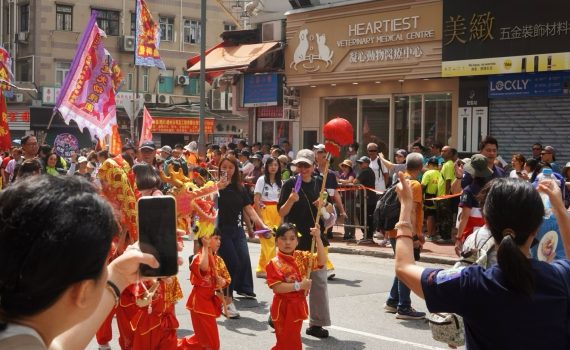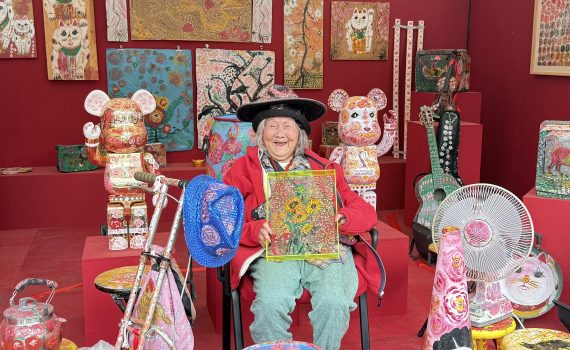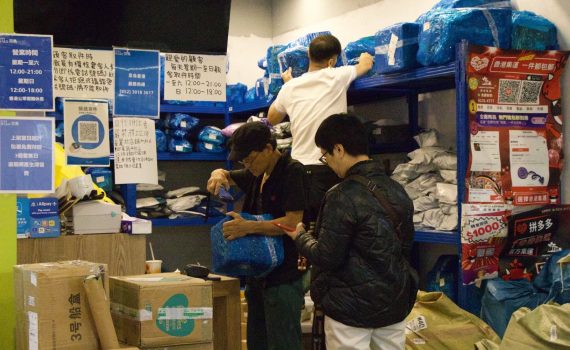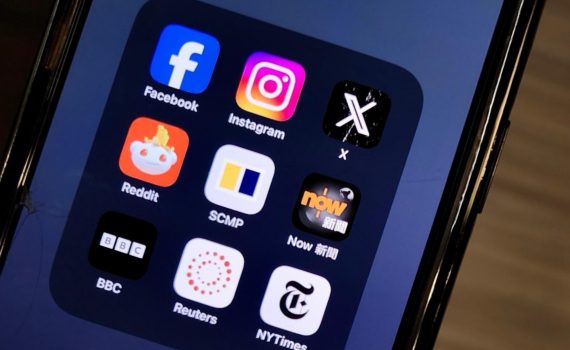Uncategorized
Largest Tin Hau Festival in Hong Kong Celebrated in Yuen Long
- 2025-04-21
- The Young Reporter
- By: CAO Siyuan、YAM Long Hei JamieEdited by: HWANG Saewon
- 2025-04-21
The Shap Pat Heung Tin Hau Festival parade, a three-hour procession from Yuen Long Town to Tai Shu Ha's Tin Hau Temple, featured 37 performing teams and attracted numerous visitors on April 20. The parade started at 10 a.m., featuring teams with paper flower tributes, as well as dragon and lion dances plus cultural performances. The parade, organised by Yuen Long's Shap Pat Heung village is the largest Tin Hau Festival celebrations in Hong Kong and is a tradition that dates back over half a century. Emily Yeung, a bank clerk, is a member of a temple performance team from Yuen Long. “I don’t live in Yuen Long, but I come to this temple to worship,” she said. This is her fourth year in this Tin Hau Festival parade. She volunteered because of her religious beliefs. “Because the movements are not very complicated, I don't need to practice for a long time every year. We only rehearsed two or three times,” she said. Spectators lined Hok Yip Road to watch the performance, and cheered from time to time. “This event is really colorful and interesting.We can even touch the dragon,”said Peter Schulz, a 57-year-old German visitor traveling with his family. “I also like the different movements of the dragons. They are very powerful,” Schulz said. “It is very colourful. I like the culture and it is very beautiful,” said Peter’s daughter, Clara Schulz. A 14-year-old lion dancer, Wu Yong-cong, has been learning the dance for two years. His lion dance teacher invited him to participate in the parade. “The festive atmosphere here really attracts me, and participating in the performance also brings me great satisfaction.” Wu said. A restaurant owner, Ms Ng, aged 80, wishes for peace and prosperity through this parade. “Although there are many visitors in Yuen Long, …
Preserve the collective memories of public housing estates
- 2025-04-18
- Culture & Leisure
- The Young Reporter
- By: QIN Ziyang、LAU Ka YanEdited by: WONG Hong Ni
- 2025-04-18
The percentage of the Hong Kong population currently living in public housing estates is 33.5%, and some of them are scheduled for redevelopment in the coming years. A series of initiatives have been triggered to preserve the memories, stories, and uniqueness associated with the estates before they are redeveloped. Aiko Kan Pui-shan, 35, who grew up in Yat Tung Estate in Tung Chung, has travelled to 230 public housing estates so far. Believing the most important and nostalgic thing about public housing estates is their memories, she set up a social media account to share her travels with the public. “I hope to make more videos of the public housing before they are redeveloped. It would be a pity if nothing is left and we forget what the estate looks like,” said Kan. Kan is also the author of Exploring Hong Kong’s Public Housing, a book that tells the history and anecdotes of the estates’ origins. She uses hand-drawn maps to portray the scenery and introduce it to a wider audience. “I published the book to share what I have seen and heard from my travels to public housing because I believe that books are something that can be passed on forever,” said Kan. “It is a good opportunity to present to the public what I have in mind for the housing estates.” “I believe that every era has a collective memory. If it has to be torn down in the future, or if it has to face redevelopment, I can say it symbolises the end of an era,” she added. In 1954, following the devastating Shek Kip Mei shantytown fire that left 53,000 residents without a home, the Hong Kong government took its initial step towards providing housing solutions. It commenced the construction of bungalows and resettlement blocks, which …
Snap Back in Time: The Film Photography Craze Sweeping Hong Kong
- 2025-04-16
- Culture & Leisure
- The Young Reporter
- By: LEUNG Chi Ngai、CHEN ZiyuEdited by: CHAN Wing Yiu、CHEN Yik Nam
- 2025-04-16
Old fashioned roll film cameras are the new craze among young people in Hong Kong. Social Media Posts that carried the hashtag of “film photography” reached over 86,000 in total. Film cameras, first sold and popularised by the American company, Eastman-Kodak Co. In 1888, images captured by a roll film camera needed to be processed in a dark room. The process is called albumen print, papers need to be printed with a layer with egg white and salt to ensure the smoothness of the surface. After the chemical reaction between silver nitrate and salt is exposed to the sun, a print is finally complete. Tang Pik-san has been using film photography since 2022 . It costs him HK$500 every month. “The biggest difference between film and digital cameras is that you can’t check the photo result immediately, which makes the photograph process mindful to me. I can simply focus on the composition of the photograph,” Tang said. The cheapest digital camera is around HK$3,000, while a disposable film camera costs around HK$100. Developing the film costs around HK$50, Tang said starting film photography is relatively cheaper. College student, Stephen Fu, 20, tried film photography for the first time four years ago. “At first it was just for fun, then I realized that film photography is completely different from digital photography. It was slower, quieter, which I love,” Fu said. For Fu, the biggest charm of the film camera is the connection between the user and the camera. “Film cameras make me think carefully every time when I press the shutter, making the time of shooting more precious,” he said. The sale of film cameras in the Chinese market increased by 3.6% over the past two years, according to The Film Camera Report 2025. The sale of products related to photographic …
Popularity soars amid the venue challenge for local pickleball and padel
- 2025-04-16
- Society
- The Young Reporter
- By: LIN Xiaoyou、YAM Long Hei JamieEdited by: WANG Ludan
- 2025-04-16
Chu Fuk-ling and Jack Zhu vigorously swung their paddles, and the ball swiftly crossed the net. They secured third place in the men's doubles at the Hong Kong round of the 2024 Pickleball World Championships in December. “Pickleball has evolved in terms of speed and technical variety in recent years, and players now not only master the standard forehand and backhand shots but also frequently employ techniques such as drop shots, which are used to surprise opponents,” said Ho King-choi, a coach with the Pickleball Association of Hong Kong, China. Racket sports, such as pickleball and padel, are gaining popularity among people of all ages, leading to an increase in various programmes and clubs aimed at promoting these emerging sports in Hong Kong. However, when it comes to venue allocation, pickleball benefits from government support, which provides more accessible public venues, while padel does not. Pickleball has been around since 1965, but it has picked up in popularity over the last few years. A bit like a combination of tennis and badminton, two or four players use a smooth-faced paddle to hit a hollow plastic ball over an 86-centimetre-high net until someone wins. In the US, pickleball is the fastest-growing sport, with more than one million children playing and has the largest participation rate from those aged 25 to 34, according to the Sports and Fitness Industry Association report in 2024. Hong Kong has more than 12 public venues for playing pickleball, and the city ranked among the top 11 in regional search popularity for pickleball, according to Google Trends. Joanna Hiew, a pickleball player, was watching the finals of a pickleball tournament and said anyone can participate in the competition as long as they form a team. “The tournament of pickleball is usually flexible, with the team of the …
Elderly flower girl turn artist puts on a show at Victoria Park
- 2025-03-17
- Society
- The Young Reporter
- By: CHAN Hiu Ying、LAU Ka YanEdited by: LI Sin Tung
- 2025-03-17
94-year-old local artist, Fapopo, who will not disclose her real name, put on a display of her own with her floral design on furniture and canvases at this year’s Hong Kong Flower Show. Fapopo is her pseudonym for the public. She has been planting, drawing, and arranging flowers for over 50 years. It started when she sold flowers at Mong Kok Flower Market in her twenties and that deepened her passion for floral painting. “I was poor and had no money to buy canvases at first, so I just used unwanted furniture to draw,” she said. “I really appreciate Fapopo’s passion and I am glad that I got to know her story at this year’s Flower Show,” said Ada Tam, a 60-year-old retiree. “Her fascinating journey in pursuing her dream is also very much in line with this year’s theme.” “Ablaze with Glory,” is the theme of this year’s Hong Kong Flower Show, organised by the Leisure and Cultural Services Department (LCSD). The Cosmos, a flower that symbolises resilience and strength, is this year’s chosen flower. Some 40,000 varieties of it are on display in an array of colours including yellow, pink and white. A total of 238 organisations participate in this year’s event, including 157 from Hong Kong and 81 from 11 countries. Raymond Ng, a 77-year-old photographer, said the Cosmos is now growing well as early spring brings ample but not intense sunshine. Its brightness brings vitality to Hong Kong. Eileen Lau, a retiree in her sixties, said the Cosmos is appealing and colourful, which can represent the vibrancy as the theme of the show. “But I also worry if the Cosmos would wither easily because it looked so fragile and thin,” Lau said. “I actually do not have much feeling about the chosen flowers as I care …
Room for improvement in protecting consumer rights in online shopping
- 2025-02-27
- Business
- The Young Reporter
- By: ZHANG Yiping、QIN ZiyangEdited by: WONG Hong Ni
- 2025-02-27
Jiong Jiali, 23, a Malaysian customer, was disappointed when she received a pair of trousers she bought from an Instagram shop in February last year. “This is nothing like the high-quality homemade trousers the shop claimed to sell,” she said on Rednote, a Chinese social media platform. The cutting of the trousers was awkward, and they hung loose around her waist and dragged on the floor. “What is worse is that the shop offered to change the trousers to a smaller size only if I cover the cost of shipping,” said Jiong. “It means I spent over HK$90 on this disappointing pair of trousers.” Despite the sluggish performance of the retail industry, online shopping has been blooming, as the total sales of Hong Kong stores without a physical storefront reached HK$1.41 billion in November 2024 after consecutive 17 months of year-on-year growth. However, the number of consumer complaints regarding online shopping are also on the rise. In 2023, online shopping complaints saw an increase of 19% from the previous year, reaching 12,696 cases and accounting for two-fifths of the total number of retail complaints received, according to the Consumer Council. The amount of money involved also increased by 20% from the previous year, exceeding $43 million. Online shopping consumers often face problems such as delayed delivery, goods not matching descriptions, counterfeit and copyright-infringing products, and difficulties in returning and exchanging goods. According to the Annual Report of the Consumer Council, in 2024, delays, non-delivery and loss of couriers was the most prominent issue, accounting for 24% of total complaints with 3,969 cases recorded. Dr. Yang Lin from the faculty of law at the University of Hong Kong, who specialises in dispute resolution and e-commerce law, said the rise in consumer complaints is a result of a lack of government regulations. …
Budget 2025: Third medical school to be decided soon
- 2025-02-26
- Health & Environment
- The Young Reporter
- By: XU Jingyi、Wong Kit YingEdited by: HWANG Saewon
- 2025-02-26
The government will decide this year which university will run the new medical school, Paul Chan Mo-po, Financial Secretary, said in his budget address today. The new third medical school was announced in October last year and local universities were invited to submit proposals. The Task Group listed out ten key parameters for the third new medical school on Nov. 28, 2024, including innovative strategic positioning from other two local universities; collaboration with healthcare institutions in the Greater Bay Area, student admission programme to both local and non-local students etc. Three universities have said they will submit proposals, including Hong Kong Baptist University which runs the city’s only school of Chinese Medicine. Dr. Manson Fok, the co-chairman of the HKBU Preparatory Committee for the new hospital, said in a public meeting on Feb 24 that the vision for the new medical school is to foster integration and cooperation of both Eastern and Western medical practices through innovative education and transdisciplinary research. Fengmei Lin, 21, a Chinese medicine student at HKBU, said, "If the new medical school can be successfully established, it will be able to achieve a deep integration of Chinese and Western medicine, and further improve the construction of Chinese medicine clinics." "We urgently need to build a new medical school and increase the number of admissions,” said Nickie Chen, an assistant teacher of Chinese medicine at HKBU. “At present, we already have a Chinese medicine hospital, and HKBU’s lack of a Western medicine hospital restricts the development of students.” Lin Chenxi, a year 4 Chinese medicine student, said, “Once the new medical school is established, we will have a stable internship place and more employment opportunities after graduation. This is effective in solving the shortage of medical personnel, which is of great significance to the sustainable development of …
Shift in news consumption habits gives rise to donation-based revenue model
- 2025-02-19
- Society
- The Young Reporter
- By: AU YEUNG Jim、YAM Long Hei JamieEdited by: NG Natasha Goa Sheng
- 2025-02-19
Tang Ho-wing, 36, is an independent journalist running the news outlet, “boomheadhk”, on social media platforms such as Facebook and Instagram. The page mostly covers local and international political issues, and has attracted over 22,700 followers. “Hongkongers' news consumption habits have shifted. Increasingly, they want to consume content not covered by the mainstream media or specialised content that features unique views,” Tang said. The main purpose of his outlet is to supplement the mainstream media and offer readers new insights on social issues. Tang’s outlet relies on readers’ donations to cover the cost of his reporting work. “When people want to read more specialised and unique reporting, or lesser-known content, they are willing to pay,” Tang said. According to Reuters Institute Digital News Report, in an online survey of 2,000 respondents in Hong Kong, only 18% said they pay to access news online in 2024, down from the peak of 29% in 2020. The report added that because the public’s news consumption habits have changed and advertising revenue has declined, media organisations that struggle in adapting to the rapid change have reported financial losses. Hong Kong Free Press, an independent non-profit news media that relies on readers’ donations, reported a HK$1.4 million loss in 2023, according to its annual report. HKFP has 895 regular monthly donors as of 2023. Damon Wong Chun-pong, Chief Editor of InMedia, a local online independent news outlet, said his outlet did not experience significant financial losses. “The drop in paid readership following 2020 is a full picture that includes the closure of mainstream media outlets, such as Apple Daily and Stand News,” said Wong. “By comparison, our readership didn’t drop a lot.” He said some readers follow other small and new news outlets after some closure of some of the mainstream outlets. The newcomers include …
Meet Hong Kong-born Giant Panda Twin Cubs
- 2025-02-17
- Society
- The Young Reporter
- By: Wing Chi HO、ALISHIBA MATLOOBEdited by: Chun Lim LEUNG
- 2025-02-17
Giant Panda twin cubs meet the media at Hong Kong Ocean Park ahead of their public debut on Sunday (February 16). Reporter: Wing Chi HO, Alishiba-Matloob Editor: Chun Lim LEUNG

Bubble-tea giant Guming delivers first-day slump amid saturated market
- 2025-02-12
- Business
- By: ZHAO RuntongEdited by: Haoming Zhou、XIA Fan、BO Chuxuan
- 2025-02-12
Shares of bubble tea seller Guming Holdings Ltd. reversed direction after a mild rise during its trading debut on Wednesday at Hong Kong, closing with a first-day slump. Trading under the code 1364, the stock of Guming rose to an intraday high of HK$10.4 before dropping 6.4% from the offer price to HK$9.3 at closing. The Hang Seng Index added 2.64% to 21857.92 as of market close. Priced at HK$ 9.94 in its initial public offering, at the top of an indicated range, Guming successfully raised $232 million in Hong Kong two days before its trading debut. 5 cornerstone investors were introduced in its IPO with a total amount of US$71 million invested, including Huang River Investment, a subsidiary of Tencent Holdings. Guming also achieved about 195 times oversubscription, which was the second best performance among tea beverage concept stocks, surpassing Chapanda but lower than Nayuki’s 430 times. “The plunge of Guming’s trading debut is due to the oversaturated market in China,” said Louis Wong Wai-jie, director of Phillip Securities, “the buyers are not optimistic about the industry’s prospects.” China’s bubble tea market has developed rapidly in the past decade, with more than 60,000 related enterprises being newly registered every year since 2017, and the market value of the industry grew to more than 300 billion RMB (HK$319. 59 billion) in 2024, according to Statista research experts. As of today, the stock price of Chapanda, also known as CHABAIDAO, has dropped nearly 23% since its IPO in April last year, while the stock price of Nayuki Holdings Limited, China’s leading tea beverage brand, plunged more than 92% to HK$1.29. As the leader of mid-priced bubble tea, which holds 17.7% of market share based on the Gross Merchandise Value in 2023, Guming choose to distribute nearly 80% of its stores in …









